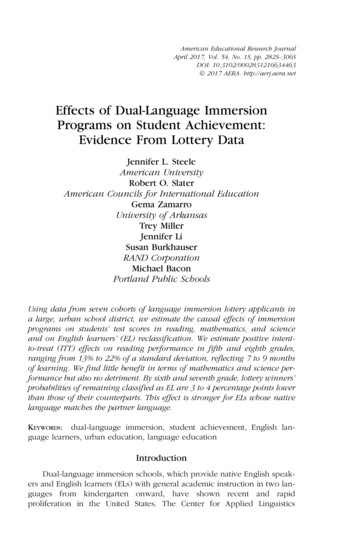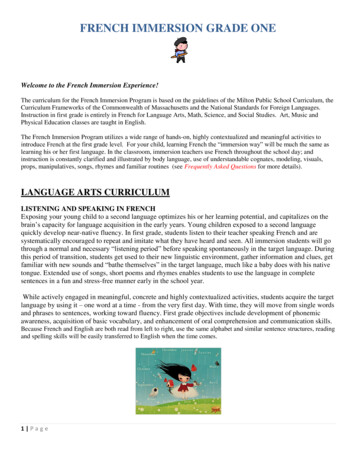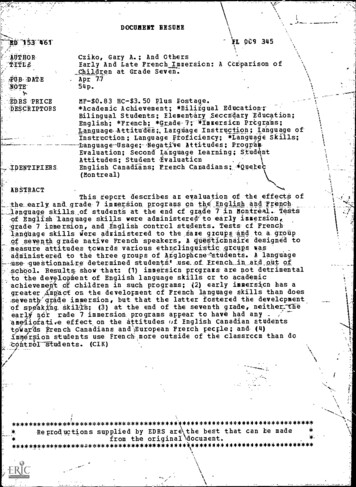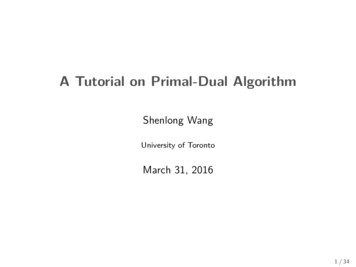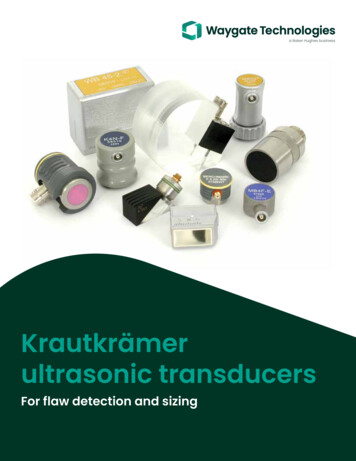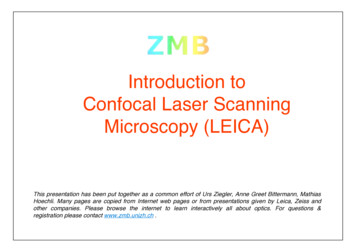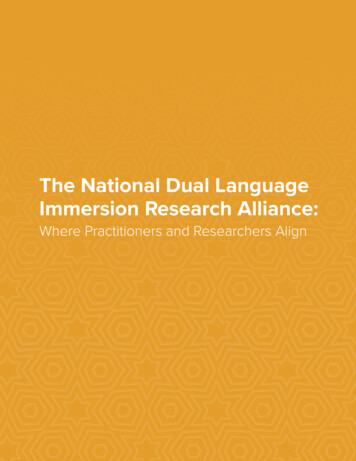
Transcription
The National Dual LanguageImmersion Research Alliance:Where Practitioners and Researchers Align
AMERICANCOUNC ILSFOR INTERNATIONAL EDUCATIONThe National Dual Language Immersion Research Alliance:Where Practitioners and Researchers AlignWe are at a tipping point of a truly significant innovation in preK-12 education that holds great promise to level theacademic playing field for hundreds of thousands of students across the United States.Dual language immersion (DLI) programs are rapidly emerging and becoming prominent in school districts andstates, both rural and urban, across the country. As the linguistic diversity of U.S. schools continues to expand, duallanguage immersion opens exciting new opportunities for students to use their linguistic abilities as key assetsin expanding multilingual instruction with native English-speaking students. Dual language programs provideboth native English speakers and English learners (ELs) with academic instruction in two languages from as early aspre-Kindergarten onward.These programs have been found to significantly raise student achievement in core subjects for both ELs andnative English speakers. With a rapidly expanding national population of non-native speakers of English, duallanguage immersion programs provide a compelling approach that offers all students an opportunity to excel in allacademic subjects.The emphasis on equity and equal access to quality education demands the inclusion of dual language programsas an integral component of the algorithm. Dual language education opens a necessary window for educationalequity by increasing the achievement of all students while also reducing achievement gaps between differentgroups of students and eliminating predictable trends about which students are the highest and lowest achieving ina school system.Our Alliance And MissionThe National Dual Language Immersion Research Alliance (Alliance) is a new network of K-12 practitioners andeducation researchers. The mission of the Alliance is to advance quality and build capacity in additive duallanguage learning programs by identifying core features and variables for quality implementation to preparestudents to be bilingual, biliterate, bicultural, and career and college-ready. The Alliance is positioned to addressthe research and policy relevant issues that can insure long-term success for this important intervention strategy.1828 L Street N.W., Suite1200, Washington, D.C. 20036 T 202 833 7522 F 202 833 7523 www.americancouncils.org
Our ObjectivesWe seek to develop and carry out a rigorous research agenda on topics that matter to all schools involved in, orplanning to be involved in, dual language learning. The Alliance will advance equity and excellence in education byproviding credible, nonpartisan research and evidence about policies and practices that promote student success.Specifically, we will: Conduct rigorous applied research in collaboration with policymakers, educators, and other stakeholders; Develop and maintain an archive of available longitudinal data on dual language immersion programs andcommunities to support ongoing research; and Disseminate research findings to multiple audiences around the nation.Critical Research AreasEducational innovation must not occur in a vacuum. Practitioners currently engaged in developing andimplementing dual language immersion programs across varied settings need systematic and comprehensiveguidance and answers to questions and issues that impact the quality, cost, and sustainability of their efforts.During its startup, the Alliance has begun to identify the pressing curricular and policy questions that areconsistently raised by practitioners. We highlight some of the key areas below, which directly inform our currentresearch agenda. How do student academic, linguistic, cultural, cognitive, non-cognitive, and socio-emotional outcomes inDLI programs compare to non-DLI programs— including English-immersion and traditional bilingualapproaches? How do different program models impact results? What are the best models to adopt? Do ELs do better academically in DLI programs when compared to non-DLI programs? How does the effect of DLI programs on student outcomes vary by student characteristics, teacher profiles,DLI program types, and instructional environments? How can programs accommodate students who enter after grades K-1? What are the best approaches to identifying schools for DLI programs, what is the potential impact of DLIprograms on local neighborhoods, and how do we achieve equity for all students, including AfricanAmericans? What types of assessments should school district officials use to monitor and evaluate the outcomes ofstudents participating in DLI programs? What are the best approaches to teacher credentialing and professional development and how do teacherpractices in DLI impact student performance?2
How can elementary-level teacher prep programs incorporate the needs ofDLI teachers?About The Researcher-Practitioner AllianceRepresenting an initial network of more than 450 dual language programs with approximately 70,000 studentsenrolled from elementary through high school, our alliance of K-12 practitioners and researchers is formed around ashared need for better evidence about problems, issues, and practices associated with developing andimplementing dual language immersion programs in secondary schools across the U.S.Given the significant role that dual language learning can play in addressing longstanding equity issues in U.S.preK-12 education, it is essential that practitioners have access to the best policy-oriented research available.The Alliance will follow the lead of best practices in researcher-practitioner partnerships by creating a fullycollaborative environment in which practitioners bring their questions to researchers so that the two communitiesmay jointly explore broader lessons for the field. To enable educators and policymakers to deliver programs bestsuited to fulfill the potential of this promising intervention, we believe that researchers and practitioners must worktogether to bring evidence to decisions about practice and bring the realities of practice to inform research.Our Alliance structure creates an environment in which researchers can study the core problems facing districtsand states and then work with practitioners to build the capacity to improve practice.Our Guiding PrinciplesOur researcher-practitioner partnership is distinguished by a number of guiding principles and relatedorganizational capacities. We have borrowed heavily from the experience of other successful educational alliances,most specifically the Research Alliance for New York City Schools, to inform our process. These adopted principlesinclude: Genuine engagement with education stakeholders; High standards of scientific rigor; Establishment of a longitudinal data archive to support research; Clear communication of findings to a range of audiences; and Multiple funding sources to help ensure independence.3
Our TeamThe Alliance is administratively housed at the American Councils Research Center (ARC) at American Councils forInternational Education. ARC brings years of experience in education research, second language learningpedagogy and assessment, and education policy. ARC’s parent organization, American Councils (a nonprofitorganization), brings 40 years of experience in developing and administering programs in international education,academic exchange, language acquisition and assessment and research. Our model is simple and straightforward.It is designed to facilitate and encourage collaboration among researchers and collaborators and to ensure thateverything we learn is effectively disseminated throughout the education community.The Alliance is led by ARC’s Co-Director Dr. Robert Slater, a highly experienced researcher and project director whorecently co-directed a major Institute of Education Sciences-funded grant project on dual language and academicperformance in Portland, Oregon Public Schools.Under Dr. Slater’s direction, ARC will work closely with the Alliance’s researchers and participating practitioners toidentify teams to address specific research questions and issues. Each team will be unique in its composition ofresearchers and practitioners.To ensure that the Alliance addresses a wide spectrum of research and policy questions that reflect the needs andconcerns of school districts, we have identified a Steering Committee that works toward setting the agenda andfuture of the partnership.Steering Group Members Mr. Michael Bacon, Assistant Director, Department of Dual Language, Portland (OR) Public Schools Dr. Donna Christian, Senior Fellow and President Emeritus, Center for Applied Linguistics, Washington, D.C. Ms. Helga Fasciano, Dept of Public Instruction, North Carolina State Board of Education Ms. Lynn Fulton-Archer, Education Specialist, Delaware State Office of Education Dr. Jennifer Li, Management Scientist and Senior Linguist, RAND Dr. Margaret Malone, Director of Assessment, Research and Development, American Council on theTeaching of Foreign Languages (ACTFL) Ms. Rosa Molina, President, Association of Two-Way and Dual Language Education (ATDLE) Mr. Gregg Roberts, World Languages Specialist, Utah State Board of Education Ms. Sylvia Romero-Johnson, Executive Director, Office of Multilingual and Global Education, Madison (WI)Public Schools Dr. Robert Slater, Co-Director, American Councils Research Center (ARC)4
Dr. Johanna Watzinger-Tharp, Associate Professor, Department of Linguistics, University of Utah Dr. Jon Valentine, Director, Foreign Language Programs, Gwinnett County (GA) Public SchoolsOur Practitioner PartnersWe are joined in this effort by a strong group of founding practitioner partners. These partners already representmore than 450 dual language programs, approaching and likely to soon surpass 70,000 students enrolled in theseprograms. An overview of each of these school systems is provided within this document. Cave Creek Unified School District, Scottsdale, AZ Delaware Department of Education, World Languages and International Education District of Columbia Public Schools Gwinnett County (GA) Public Schools Los Angeles Unified School District Madison (WI) Metropolitan School District, Office of Multilingual and Global Education North Carolina Department of Public Instruction Portland (OR) Public Schools, Department of Dual Language Utah State Board of Education, World LanguagesOur Researcher PartnersThe Alliance is built to facilitate collaboration among our nation’s best researchers and practitioners. Moreimportantly, the Alliance is designed to insure an effective laboratory for communications between researchers andpractitioners, particularly a milieu where practitioners bring problems to the Alliance. We have gained commitmentsfrom established researchers and will continue to expand this list as we progress and as projects require. Ourresearchers encompass a diverse range of disciplines and professions including education policy, second languagelearning, assessment, econometrics, and linguistics. See our section on Researcher Partners for biographies of theorganizations that are already committed to the Alliance.Dr. Beatriz Arias, Vice President, Center for Applied Linguistics. Dr. Arias, formerly Associate Professor at ArizonaState University, is CAL’s Chief Development Officer and director of professional development and online educationactivities. Her research deals with educational policy, teacher preparation, and programs for English learners. Shehas provided expertise in school desegregation cases across the nation, focusing on programs that promote equityfor English learners, including bilingual/dual language programs.Dr. Richard Brecht, Co-Director, American Councils Research Center, American Councils for InternationalEducation. Dr. Brecht is an internationally recognized expert on second language learning. He brings five decades5
of leadership in language research and policy on behalf of education, government, heritage communities, privatebusiness and NGOs. He has been a founder and leader of more than a dozen national language organizations andprojects, including the National Foreign Language Center and the Center for the Advancement of Language at theUniversity of Maryland.Dr. Donna Christian, Senior Fellow, Center for Applied Linguistics (CAL). Dr. Christian held the position of Presidentof CAL from 1994-2010. For over 20 years, she has been involved in research, professional development, andtechnical assistance related to two-way bilingual immersion, including a study for the National Center for Researchon Education, Diversity & Excellence (CREDE), funded by the U.S. Department of Education.Dr. Dylan Conger, Associate Professor, Trachtenberg School of Public Policy, George Washington University. Dr.Conger’s research concerns disadvantaged, immigrant, and minority youth with a focus on education policies andurban areas. Current projects include examining the effects of public policies and programs on the educationaloutcomes of undocumented immigrant and English Language Learners from early schooling through postsecondary; estimating the effect of Advanced Placement and other advanced high school courses on educationaloutcomes; and identifying the sources of gender disparities in secondary and post-secondary educationaloutcomes.Dr. Dan Davidson, President, American Councils for International Education. Dr. Davidson has focused much of hisprofessional life on the development, oversight, and support of international initiatives in educational development,training, and research, primarily through the work of American Councils and its partner organizations in the U.S.,Eurasia, Africa, the Middle East, and Asia. Dr. Davidson also holds the rank of Professor at Bryn Mawr College.Dr. Patricia Gandara, Research Professor & Co-Director, The Civil Rights Project, UCLA. Dr. Gándara is Professor ofEducation at UCLA. Her professional interests in graduate teaching include education policy/education reform,social context of learning, learning and assessment, and educational equity/bilingual and multicultural education.She has published extensively on issues related to the education of Latino students, particularly English learners,and the benefits of bilingualism and biliteracyDr. Kathryn Lindholm-Leary, Private Consultant. Dr. Lindholm-Leary is currently Professor Emerita of Child andAdolescent Development at San Jose State University. Her research interests focus on understanding the factorsthat influence student achievement, with a particular emphasis on culturally and linguistically diverse students. Dr.Lindholm-Leary has one of the most comprehensive longitudinal data sets on bilingual students, particularlystudents in two-way programs, in the country.6
Dr. Jennifer Li, Management Scientist, The Rand Corporation. Dr. Li conducts research on language education,language policy, organization development, training, and workforce issues. Dr. Li led the qualitative component ofthe study of dual language education in Portland, Oregon and conducted the analysis of implementation practicesacross the district. Other past projects have addressed school leadership, charter schools, language assessment,and the retention of heritage languages among children of immigrants.Dr. Margaret Malone, Director, Center for Assessment, Research and Development, ACTFL. Dr. Malone served asAssociate Vice-President of World Languages and International Programs at the Center for Applied Linguistics(CAL). The author of numerous publications on assessment, she brings extensive experience in language testdevelopment, data collection, survey research, and program evaluation. She is also Co-Director of the Assessmentand Evaluation Language Resource Center (AELRC) at Georgetown University.Ms. Myriam Met, Private Consultant. Ms. Met works K-12 with language programs and teacher professionaldevelopment in K-12 education. She was Acting Director of the National Foreign Language Center and a seniorresearch associate at NFLC prior to her retirement. She was also a supervisor of foreign language instruction formajor urban and suburban school districts for over 25 years. In that capacity, and as a consultant to educationalagencies, she planned, implemented, and evaluated K-12 language programs including elementary and secondaryprograms.Dr. Trey Miller, Economist, The Rand Corporation. Dr. Miller is an economist at RAND whose research focuses oneducation policy. He has lead quantitative and mixed methods research projects with multi-disciplinary researchteams and a combined budget of over 10M for clients including the Institute of Education Sciences, the LuminaFoundation, the Bill and Melinda Gates Foundation, the Houston Endowment, the Spencer Foundation, and the U.S.Department of Defense.Dr. Robert Slater is Co-Director of the American Councils Research Center. Most recently he co-directed a U.S.government funded study examining the impact of dual language immersion programs on K-12 academicperformance. Dr. Slater served as Director of the National Security Education Program (NSEP) where he establishedthe highly successful Boren Scholarship and Fellowship programs, the Language Flagship program and theNational Language Service Corps. He is an accomplished political scientist and methodologist and has published inmajor scholarly journals.Dr. Jennifer Steele, Associate Professor, School of Education, Teaching and Health, American University. Dr. Steelewas the Co-Principal Investigator on the recently completed Department of Education (Institute of EducationalScience) study of the impact of Dual Language Immersion on Academic Performance in Portland (OR) Public7
Schools. Her research, which emphasizes quantitative methods that support causal inference, focuses on urbaneducation policy at the K-12 and postsecondary levels.Dr. Johanna Watzinger-Tharp, Associate Professor of Linguistics, College of Humanities, University of Utah. Dr.Watzinger-Tharp’s research focuses on language pedagogy, sociolinguistics, dual language immersion, and teachereducation and has been published in a variety of scholarly journals. As co-chair of Utah’s World Language Council,she was involved in the creation of Utah’s language roadmap and dual language immersion. Since then, she hasworked with public and higher education to advance dual immersion in Utah and the U.S., and was instrumentalin passing legislation to establish Utah’s DLI bridge program for high school students.Dr. Gema Zamarro Rodriguez, Endowed Chair in Teacher Quality, College of Education and Health Professionals,University of Arkansas. Dr. Zamarro has performed research on applied econometrics in the areas of education,health, and labor. She has completed studies on heterogeneity in returns to education, on the relationship betweenteacher quality and student performance, and on the effect of school closing policies on student outcomes. Inaddition, she is researching the properties of value-added methods for estimating teacher quality.Dr. Conor Williams, Senior Researcher, Education Policy, New America. Dr. Williams is the founding director of theDual Language Learners National Work Group at New America. He is also a senior researcher in New America'sEducation Policy program. His work addresses policies and practices related to educational equity, dual languagelearners, immigration, and school choice.Our Organization PartnersThe Alliance is also structured to build on the considerable foundation of organizations already established incritical areas of education policy and dual language learning in the U.S. Collaboration with each of theseorganizations is a cornerstone to the Alliance’s efforts to ensure that our work reflects the best knowledge andexpertise available. Among those organizations committed to participating with the Alliance are:American Council on the Teaching of Foreign Languages (ACTFL)The American Council on the Teaching of Foreign Languages (ACTFL) is dedicated to the improvement andexpansion of the teaching and learning of all languages at all levels of instruction. ACTFL is an individualmembership organization of more than 12,500 language educators and administrators from elementary throughgraduate education, as well as government and industry.8
Association of Two-Way and Dual Language Education (ATDLE)The Association of Two-Way & Dual Language Education (ATDLE) was formed into a national organization in 2013.As the leading organization in Two-Way Bilingual Immersion Education, ATDLE works closely with otherorganizations and agencies that share a common vision and mission for this work.Center for Applied Linguistics (CAL)The Center for Applied Linguistics (CAL) is a private, nonprofit organization founded in 1959. CAL has earned aninternational reputation for its contributions to the fields of bilingual and dual language education, English as asecond language, world languages education, language policy, assessment and the education of linguistically andculturally diverse adults and children. CAL's mission is to promote language learning and cultural understanding byserving as a trusted source for research, resources, and policy analysis.New AmericaNew America is a think tank and civic enterprise committed to renewing American politics, prosperity, and purposein the Digital Age. As a civic enterprise, New America is committed to the solution of public problems. New Americaprovides a platform that enables individuals and groups working on these solutions to drive different stages ofchange, from inspiration to implementation.The RAND CorporationThe RAND Corporation is a nonprofit institution that helps improve policy and decision-making through researchand analysis. RAND promotes rigorous, fact-based research and analysis to help individuals, families, andcommunities throughout the world be safer and more secure, healthier and more prosperous. RAND led the majorresearch effort that explored the relationship between dual language immersion and academic performance inPortland Public Schools.The University of UtahThe University of Utah’s Second Language Teaching and Research Center (L2TReC) focuses its primary activities inthree areas: research, pedagogy, and outreach. It profiles the University of Utah's unique strengths in languageeducation and provides a focal point for research in Second Language Acquisition. The Center plays a prominentrole in supporting the state-wide, legislatively-funded dual immersion project in Utah, by promoting immersionresearch, educating pre- and in-service teachers, and assisting with immersion curriculum developments.9
Overview of Our PractitionerPartners
Our Practitioner PartnersThe Alliance, in its early stages, includes as founding partners a highly diverse set of independent school districtsand schools within state education systems. Each partner has agreed, in principle, to work within the Alliance to: Raise important issues and questions critical to the success of dual language; Participate in specific research efforts by providing expertise and student level data; and Provide access to teachers, administrators, and parents.The partners represent the diversity of school systems across the U.S. Our practitioner partners include: Three statewide systems (Delaware, North Carolina, and Utah); Three major, but very different, urban school districts (Gwinnett, GA, Los Angeles, CA, and Portland, OR);and Two smaller school districts (Madison, WI and Cave Creek, AZ).Across these states and districts, the Alliance gains unprecedented access to almost 70,000 students and over450 distinct dual language programs. Over time, the numbers of students, programs, and teachers across thesestates and districts will increase and provide an even richer pool of data. The diversity, breadth, and sheer numbersof the schools, programs, teachers, administrators, and students represented in the Alliance provide access to datathat have heretofore been entirely unavailable to researchers.10
Cave Creek Unified School District 93 (CCUSD)Arizona Public School DistrictOverview of CCUSDCave Creek Unified School District (CCUSD) covers a suburban and rural area in the north Phoenix valley. There area total of seven schools in the district (five K-6 campuses, one 7/8 middle school, and one high school). The studentbody at CCUSD is predominantly white (86 percent), with nine percent Hispanic, three percent Asian, and onepercent African American enrollment.Dual Language Immersion in CCUSDThe CCUSD World Language Immersion program currently includes four schools (three elementary schools andone middle school). Desert Willow’s Spanish Immersion program started in 2003 and has seen students go throughthe middle school immersion and the high school continuation pathway (at high school, it’s no longer an officialimmersion model, due to only one Spanish class daily). The Mandarin Chinese (grades 1-2) and French Immersion(K-1) programs are younger, but will move to later grades as the cohorts progress.EnrollmentAs of December 2016, there were 528 enrolled language immersion students and 21 language immersion teachers.Current 2016-17 dual language enrollment is distributed across schools as follows:Desert Willow Elementary School (one-way, Spanish, two-teacher model):327Horseshoe Trails Elementary School (one-way, Mandarin, two-teacher model):88Desert Sun Academy (one-way, French, self-contained model):44Sonoran Trails Middle School (one-way, Spanish, two-teacher model):69Future Steps for 2017-2018 French immersion will roll up to one 2nd grade classroom (one self-contained teacher added) Chinese immersion will roll up to one 3rd grade classroom (an English and Chinese teacher team will beadded) Spanish immersion rollup is complete K-8 with a high school continuation pathway of one class daily.11
Delaware Public SchoolsOverview of Delaware Public SchoolsThe Delaware Department of Education supports the instruction for more than 137,000 students in 201 publicschools and 25 public charter schools in 19 school districts. Delaware’s statewide student population is 46 percentwhite, 30 percent African American, 16 percent Latino, and 8 percent other.Delaware World Language Immersion ProgramsDelaware World Language Immersion Programs are part of the larger Governor’s World Language ExpansionInitiative created by Governor Jack Markell in 2011. This state-level initiative proposes an aggressive worldlanguage education plan that prepares Delaware students with the language skills to compete in an ever-changingglobal economy at home and around the world.The initiative began with the establishment of four immersion programs in 2012 and has grown to 18 programs in2016. Immersion programs have been established in 80 percent of eligible school districts across the state. Thereare four one-way Chinese immersion programs, eight one-way Spanish programs, and six two-way Spanishprograms. There are also two two-way Spanish immersion programs established in public charter schools. Whilethese programs are not affiliated with the state-level initiative, they are included in the program overview andenrollment data.The Delaware World Language Immersion Programs follow a 50/50 model in grades K-5 and begin in Kindergarten.Immersion in the state-level initiative encompasses grades K-4 and continues to grow by one grade level each yearin each school. One charter program has articulated K-6 and the other K-3 immersion.EnrollmentAs of December 2016, there were 3,780 students enrolled in immersion programs K-5. This represents 6 percent ofthe entire elementary school population across the state. There are currently 80 English language teachers, 70Spanish language teachers, and 16 Chinese language teachers serving students in these programs. Enrollment isdistributed across programs as follows:12
LanguageEnrollment hTwo-Way1197SpanishTwo-Way Charter993TOTAL3780Future GrowthProgram growth is exceeding the original targets, and it is expected that one out of every six kindergarten studentsin Delaware—more than 16 percent of total students— will be enrolled in a language immersion program during the2017-18 school year. The 2017-18 school year will see the establishment of a total of nine new state-affiliatedimmersion programs—two Chinese and seven Spanish—and one charter school Greek immersion program.Immersion will expand into middle school for the first time during 2017-18 and total enrollment is expected toexceed 5,200 students.13
District Of Columbia Public Schools (DCPS)Overview of District of Columbia Public Schools (DCPS)DCPS is an urban school district in the nation’s capital with over 48,000 students enrolled PreK–12. DCPS servesmore than 6,000 students classified as English Learners (ELs). DCPS EL students come from 140 different countriesand speak over 147 different languages, including dialects. Nearly 75 percent of DCPS EL population comes from abackground where Spanish is spoken at home. Following Spanish, Amharic, French, Chinese, and Vietnamese arethe four most commonly spoken languages of EL students.Dual Language Education Programs in DCPSIn the last 13 years, dual language programming in DCPS has grown from one program with 500 students to 11programs with over 3,000 students. All programs are Spanish/English 50/50 programs (with model variability inearly childhood). Some programs are two-way, linguistically balanced programs and others are one-way programspredominantly enrolling students from English-speaking homes. All programs have the same four goals:bilingualism, biliteracy, academic achievement, and cultural competency.EnrollmentApproximately 3,000 students are enrolled in dual language programs, with over 250 teachers supporting programstudents. For a list of dual language programs in DCPS, please visit ht
The National Dual Language Immersion Research Alliance (Alliance) is a new network of K-12 practitioners and . Multiple funding sources to help ensure independence. 3. Our Team The Alliance is administratively housed at the American Councils Research Center (ARC) at American Councils for . Associate Professor, Department of Linguistics .


